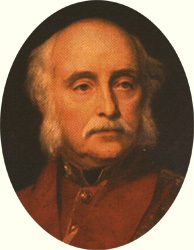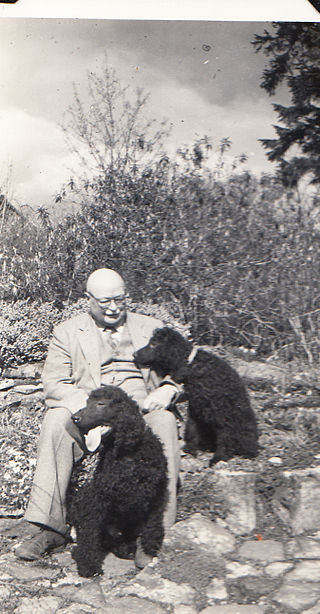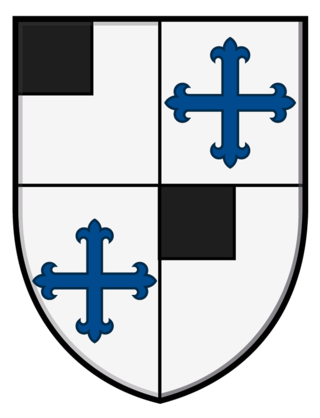
General Sir Charles William Pasley was a British soldier and military engineer who wrote the defining text on the role of the post-American Revolution British Empire: An Essay on the Military Policy and Institutions of the British Empire, published in 1810. This text changed how Britons thought their empire should relate to the rest of the world. He warned that Britain could not keep its Empire by its "splendid isolation". Britain would need to fight to gain its empire, and by using the colonies as a resource for soldiers and sailors it grew by an average of 100,000 square miles (260,000 km2) per year between the Battle of Waterloo and the American Civil War. Serving in the Royal Engineers in the Napoleonic Wars, he was Europe's leading demolitions expert and siege warfare specialist.
John Le Mesurier (1781–1843) was a soldier and governor of Alderney. He resigned his patent to the crown in 1825 and was the last hereditary Governor of Alderney.
Charles Waddington CB was a major-general in the Bombay Engineers of the British East India Company.
Charles Edmund Wilkinson (1801–1870) was a British army officer who rose to the rank of Major-General and served as acting Governor of British Ceylon.
Major-General Philip de FonblanqueDSO was a senior British officer, who at the start of the Second World War, organised the logistics for the British Expeditionary Force in France and Belgium. Already a sick man, the result of his exertions was that he died shortly after his evacuation from France in June 1940.

Lieutenant Colonel Charles Hamilton Grant Hume Harvey-Kelly (1885–1982), also known as C. H. G. H Harvey-Kelly, was a British Indian Army officer who served as Military Attaché to Kabul (1924–26). In 1926 he was awarded the MacGregor Memorial Medal for military reconnaissances and journeys of exploration.
Colonel Stuart William Hughes Rawlins, was a British Army officer who led interwar experiments in chemical warfare at Porton Down.

Brigadier-General Henry Clifford Rodes Green, was a senior British Army officer during the First World War.
Major General Francis Robert Glanville (1827–1910) was a senior British Army officer.
Brigadier General Charles Edensor Heathcote, CB, CMG, DSO was a senior British Army officer during the First World War.
Brigadier Charles Deane Steel was a British Army officer and civil servant.
Major-General Bruce Morland Skinner, was a British Army officer and surgeon who served as Surgeon-General during the First World War.

Major–General Hugh Clement Sutton was a General in the British Army, Deputy Assistant Director of Railways in South Africa between 1900 and 1902 and Lieutenant-Governor and Secretary of Royal Chelsea Hospital between 1923 and 1928.
General Walter Douglas Phillips Patton-Bethune (1821–1901) was a British soldier and landowner.
Sir John Marnoch was a Scottish surgeon and British Army officer. He was Surgeon to the Royal Household in Scotland, Regius Professor of Surgery at the University of Aberdeen, and President of the Aberdeen Medico-Chirurgical Society.
The Antrim Artillery was a part-time reserve unit of Britain's Royal Artillery based in County Antrim, Northern Ireland, from 1853 to 1919. It numbered 1st on the order of precedence of the Militia Artillery. Volunteers from the unit served in the Second Boer War. During World War I it defended Belfast Lough and trained gunners for service overseas. Subsequent units continued the Antrim Artillery traditions.
James Gustaf Edward Le Mesurier was the British co-founder of the White Helmets, a volunteer civil defence organisation in the Syrian Civil War, founded in southern Turkey in 2014. Le Mesurier was a British Army officer and worked as part of the United Nations peacekeeping force in the former Yugoslavia. He was the director of the non-profit Mayday Rescue Foundation, headquartered in the Netherlands. Le Mesurier died in a fall from the balcony of an Istanbul building where he kept an apartment and an office.

The following units of the British Armed Forces participated in the Battle of New Orleans on 8 January 1815. The American order of battle is shown separately.
As part of the British honours system, Special Honours are issued at the Monarch's pleasure at any given time. The Special Honours refer to the awards made within royal prerogative, operational honours, political honours and other honours awarded outside the New Years Honours and Birthday Honours.

Lieutenant-Colonel Rowland Edward Power was in Command of the 1st Battalion of the South Nigeria Regiment between 1905 and 1906, the 2nd Battalion of the Buffs during World War I, the 1st Battalion of the Buffs at the end of World War I, and from 1923 until his retirement in 1927, the 1st Battalion of the Buffs in Gibraltar.





